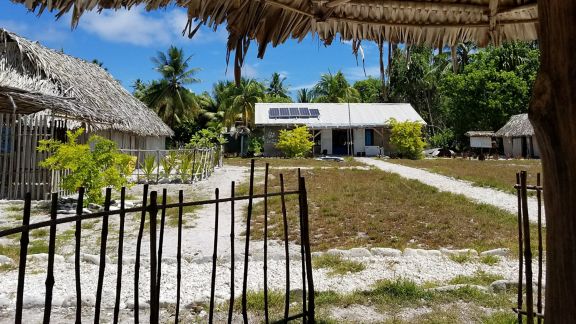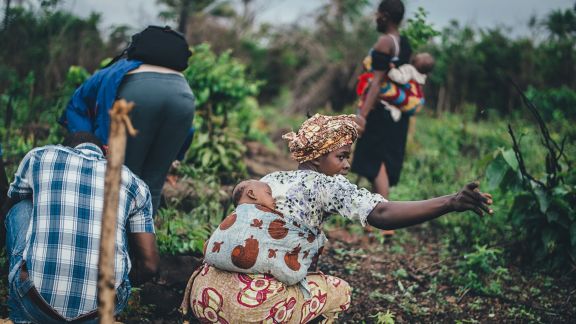NORC Finds Promise in Conflict Resolution Efforts in Northern Ghana

This article is from our NORC Now newsletter. Subscribe today.
August 2025
We used culturally aware methods for a randomized control trial evaluating conflict resolution strategies at the edge of West Africa’s Sahel region.
In the Upper West region of Ghana, conflicts between local farmers and ethnic Fulbe cattle herders have grown increasingly frequent and violent in recent years. NORC at the University of Chicago conducted a mixed-methods evaluation of a conflict resolution and community resilience strategy implemented by two Ghanaian organizations, the Center for Conflict Transformation and Peace Studies and Save Ghana. The strategy had three components:
- Facilitated dialogue sessions that brought together Fulbe and non-Fulbe community members for two-day community discussions
- Mixed Village Savings and Loan Associations with 20 to 30 members from both ethnic groups
- Mixed mediation committees with Fulbe and non-Fulbe representatives trained to resolve disputes
We prioritized cultural awareness, particularly when working with the Fulbe community.
The Fulbe population faces significant challenges in northern Ghana. Because of their previous history as nomadic cattle herders, they are commonly denied citizenship and are not considered full members of the communities where they live, even though many have been settled in Ghana for decades. They are frequently excluded from NGO programs and community decision-making.
NORC enlisted local organizations in northern Ghana that work extensively with the Fulbe people to identify qualified Fulbe enumerators to help with data collection.
“The Fulbe respondents got very excited that they were seeing people from their own ethnic group working as enumerators,” said Gregory Haugan, a NORC research scientist and the project director. “They weren’t used to seeing people from their own ethnic group in that kind of role, so there was a lot of cooperation.”
Interviewers also had to navigate cultural sensitivities around gender roles. To capture these important dynamics, they spoke with both a household head (usually male) and a female primary decision maker in each household. Cultural considerations influenced whether male or female enumerators conducted interviews and whether they were conducted publicly or privately.
Our pilot research revealed several unexpected cultural insights that informed our evaluation methodology.
During the scoping and pilot phases, we quickly realized that Fulbe respondents would not provide specific numbers for the size of their cattle herds. “It would be like a survey asking someone in the USA how much money is in their 401(k),” Haugan said. The team modified their questions to use ranges of herd numbers instead.
The research also required separate sampling strategies for Fulbe and non-Fulbe populations. For the non-Fulbe, who live in compact communities, we used random walk sampling, where enumerators started from a random starting point in the community and followed a predetermined walking pattern, interviewing households at fixed intervals along the route. The Fulbe live in dispersed settlements on the periphery, making random walk sampling impractical. Instead, NORC used the required courtesy visit to the local Fulbe chief as an opportunity to gather a list of all Fulbe households in the area, then randomly selected from that list.
Our evaluation methods gave us a comprehensive view of the intervention’s outcomes.
NORC validated the findings by using multiple data sources (in this case, a household survey, a community leader survey, and focus group discussions) to develop a deeper understanding of the intervention’s impact. Using this approach allowed us to drill down into the intervention’s mechanisms and understand why certain outcomes were observed.
We randomly sampled community members to measure the average treatment effect on the community, including respondents regardless of whether they participated in specific intervention components. Focus group discussions specifically targeted people who had been involved in different intervention components, providing direct participant perspectives.
The intervention had positive impacts across several outcome indicators.
NORC conducted the evaluation just a few months after the intervention was implemented. In that short period of time, we found the intervention led to:
- A 15 percent increase in women participating in mixed-ethnicity community savings groups
- An 8 percent increase in farmers and herders reporting that dispute resolution in their communities is usually or always peaceful
- Improved perceptions of peaceful conflict resolution and security
- Increased confidence among farmers that their crops would not be destroyed by cattle herders without appropriate compensation
The intervention aimed to build community resilience amid a backdrop of growing violent extremism in West Africa.
Part of the motivation behind the intervention is that inter-ethnic tensions and community conflicts can be exploited by violent extremist groups that have been gaining strength in West Africa in recent years.
“These groups don’t have a foothold in Ghana yet, but they’re kind of knocking on the doorstep,” Haugan said. “Building community resilience is seen as one way of keeping these groups at bay, because there’s certainly potential for them to exploit these divisions between communities.”
Our findings suggest the intervention’s three-pronged approach to mediating conflict and building resilience merits continued investment and study.
NORC included outcome indicators in our report that could allow future studies to explore the effects of those outcomes.
“The evaluation shows that these alternative community-led models for conflict mediation and reconciliation can be effective and show promise for improving the peaceful resolution of disputes, but more time is needed to see whether this translates into improved social relations,” Haugan said.
The evaluation’s findings have already gained attention from other organizations. The International Organization for Migration, which runs the Coastal States Stability Mechanism program, funded NORC to finalize and disseminate the work.
This article is from our flagship newsletter, NORC Now. NORC Now keeps you informed of the full breadth of NORC’s work, the questions we help our clients answer, and the issues we help them address.








